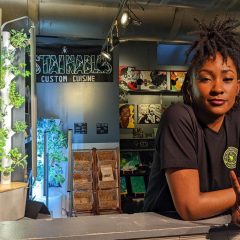Post by Andrea Kirsh
Andrea Kirsh discovers Hidden treasure, and the promise of a great party
Candy Depew and Virgil Marti have done extraordinary installations in two Philadelphia sites, and if both include gilded skulls, it may be in anticipation of the Day of the Dead, or Halloween, or merely a sign of the times. But don’t miss them.
To begin, I’d like to introduce Robert Wuilfe. He’s a lively and very imaginative young curator who figured out how to live in the best part of Center City by becoming site manager at the Powell House, e.g. he lives above the public rooms of the grand Georgian house, one of four owned by the Philadelphia Society for the Preservation of Landmarks. Robert decided to turn his day (or “night”) job into something more interesting by forming Landmark Contemporary Projects. His idea was to invite artists into the buildings as a way of bringing fresh eyes and new audiences to sites that were thought of as stuffy, if indeed they were thought of at all.
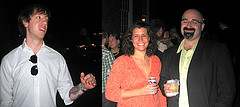
Robert Wuilfe is far right. Next to him is Philagraphika and Space 1026’s Caitlin Perkins. Far left is Anthony Smyrski of Megawords. Photo, taken at the opening at the Powel House, courtesy of Artforum online.
Robert began with a roaring success: he asked Dan Murphy and Anthony Smyrski (artists usually seen at Space 1026 and creators of Megawords, a free, populist, purely-visual artists’ tabloid) into Powell House for a week-long installation from Sept. 5-12. It began with a bang – a symposium and opening party (this, as well as the installation sponsored by Philagrafika) and the Powell House and its garden were standing-room only with a youthful art crowd that had certainly never been to the premises.
Murphy and Smyrski used video and slide projections with historic scenes from the rougher side of the streets of Philadelphia. The work made it clear that such landmarks and their furnishings are always luxury goods; the homes and furnishings of the people who built or served in the Powell House have not survived. Wuilfe reports that the changing images, seen through the windows, attracted crowds of viewers on Fourth Street at night.
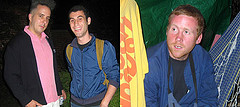
Left, Steve Powers and Matt Schwartz. Right, Dan Murphy of Megawords. Photo from the Powel House opening, courtesy of Artforum online.
The most exciting part of their project was the garden. They filled it with roughly-assembled tents, which gave the impression that someone had left the gate open and a group of homeless had moved into the manicured precinct. The crowd that first night, many in tee-shirts and baggy trousers and drinking beer from bottles, looked fairly at home. If any staid preservationists were concerned that the installation obscured the Powell House’s Federal-period grandeur, it was gone in a wink.
[Ed. note: I’ll say it was gone in a wink. Unfortunately, we at artblog missed it, so thanks, Andrea, for being our eyes on the scene! Other eyes on the Megawords/Powel House scene can be found in William Pym’s Artforum Diary online.]
Candy Depew’s skulls in the Physick House
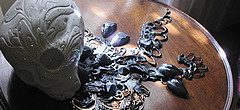
Candy Depew, installation detail, Physick House
Fortunately Candy Depew’s take on the Physick House (321 S. 4th St., 215 025-7866, ) will be up longer – until November 26. Her work is considerably gentler with the existing house; indeed, the Physick House’s rooms already looked like a 1960’s riff on its Empire period furnishings (someone papered it with fairly delirious wallpaper — think Ken Russell or Franco Zeffirelli) and perfectly made for Depew’s aesthetic. She created significant installations in the breakfast room and an upstairs bedroom, and small interventions elsewhere.
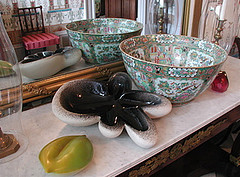
Depew’s small touches show up everywhere.
Her deft but effective addition to the fountain in the garden is a winner – I’m not revealing it – just go see it. The afore-mentioned gilded skulls appear in the breakfast room along with other Depew ceramics, some so consistent with the house’s furnishings (a luster-ware over blue and white dish) that one thinks they belong. Her ceramic table arrangement has something of the quality of a vanitas painting done in cake icing. According to Wuilfe, Depew was fascinated by the combination of history, science and decorative art that is the legacy of Dr. Physick (known as the “Father of American Surgery”), but her response to the visual exuberance of the furnishings is more obvious.
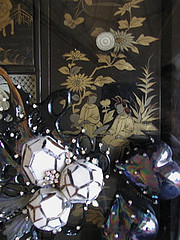
More details from Depew’s installation.
Walking into the bed-room is like entering one of Depew’s pink-patterned dreams. She has thrown a comforter (a patch-work of fabric she designed) across the bed at an angle and large biomorphic pillows are perched upon it. The bed seems to weep black tears. A rhinestone-encrusted waistcoat is hanging on the chair back, and one can only imagine the rest of its wearer’s garb. Something is going on here – a bloody sword on the day-bed suggests that we have entered one scene in a multi-act play. I wonder whether Depew saw the spectacular Dangerous Liaisons exhibition at the Metropolitan Museum of Art in 2004, where eighteenth-century French clothing was displayed on mannikin arranged within the period rooms, in race-y tableaux taken from Choderlos de Laclos’ novel.
There’s a party at Physick House on Tuesday, October 17, 6-9 pm, which deserves to be as lively as the September event. And it’s free — although Landmark Contemporary Projects welcomes donations – and will make good use of them, if one can predict from the track record.
Virgil Marti’s Crazy Quilt at the Design Center
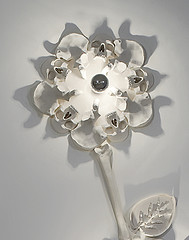
Virgil Marti, detail, Green Winter, cast skulls and bones and flowers.
And at the Design Center at Philadelphia University, Crazy Quilt, Virgil Marti’s Selected Works (up through Nov. 17, ) takes over three rooms in the otherwise spare 1950’s ranch-style house, and Goldie Paley must be turning in her grave. I think the first room is worth the trip to East Falls: a modern take on the sort of cast stucco decoration that reached its height in the eighteenth-century, huge flowers sprawling across the walls, with integral illumination. A close inspection reveals that the stems are cast from human femurs and the inner layer of flower petals, surrounding the silvered light bulbs, are skulls. The piece works remarkably well as decoration, although it would be a brave patron who installed it in a functional space in her home. What a background for late-night dinner parties; it would be wonderful if it found a home in Philadelphia.
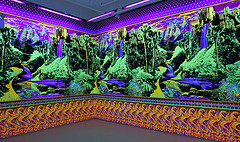
Virgil Marti, landscape wallpaper with shrooms and flames, detail.
The next room is considerably less elegant as an ensemble – an homage to Marti’s past collecting (or accumulating) habits: beer cans, kitsch figurines, shag rugs with animal heads…, you get the idea. It didn’t inspire me, but then I’m a hopeless modernist in my own decorating taste; I favor spare. And the final room – well, for those who long for the 60’s (or missed them), it’s a wrap-around, black-light take on French scenic wallpaper, with a video compilation of Marti’s favorite films (The Man Who Fell to Earth, Soylent Green).
Perhaps Depew and Marti are suggesting that we become less squeamish about death. Skull imagery has a long history within art, and it is interesting to see it presented with such subtlety as a possible part of our everyday lives.
–Andrea Kirsh is an art historian living in Philadelphia.



